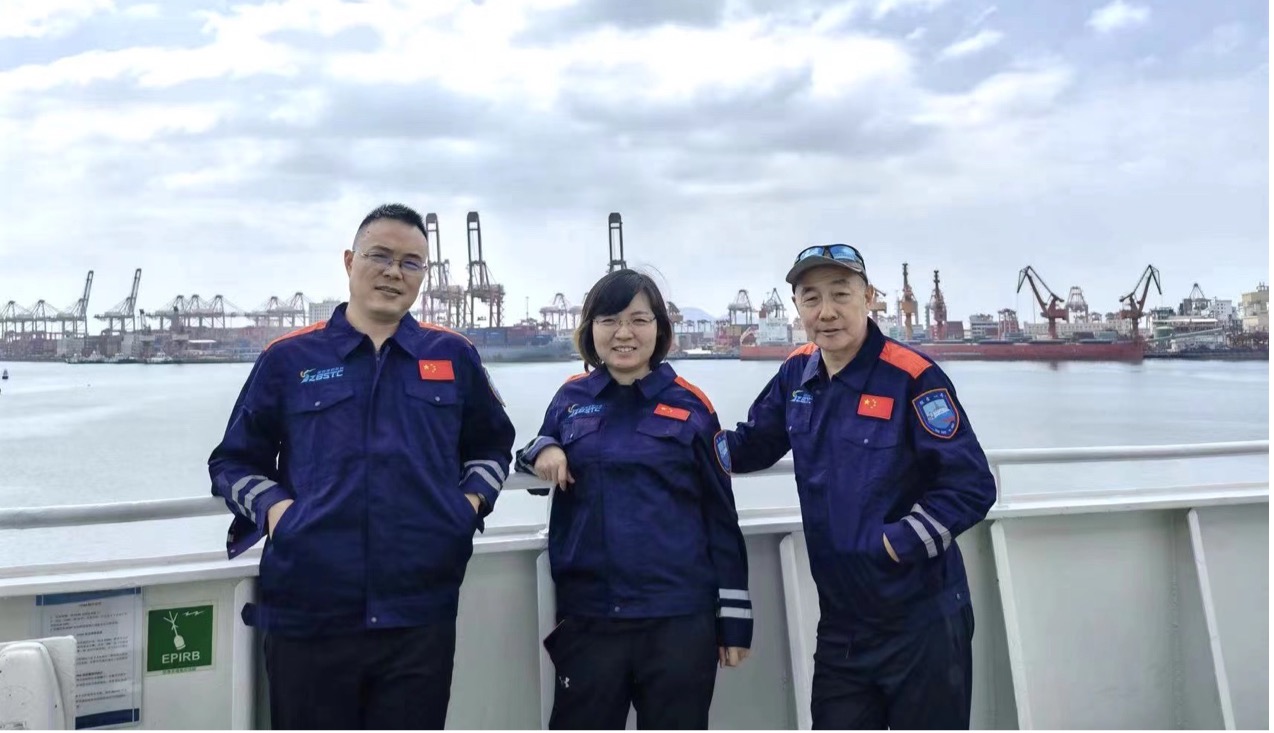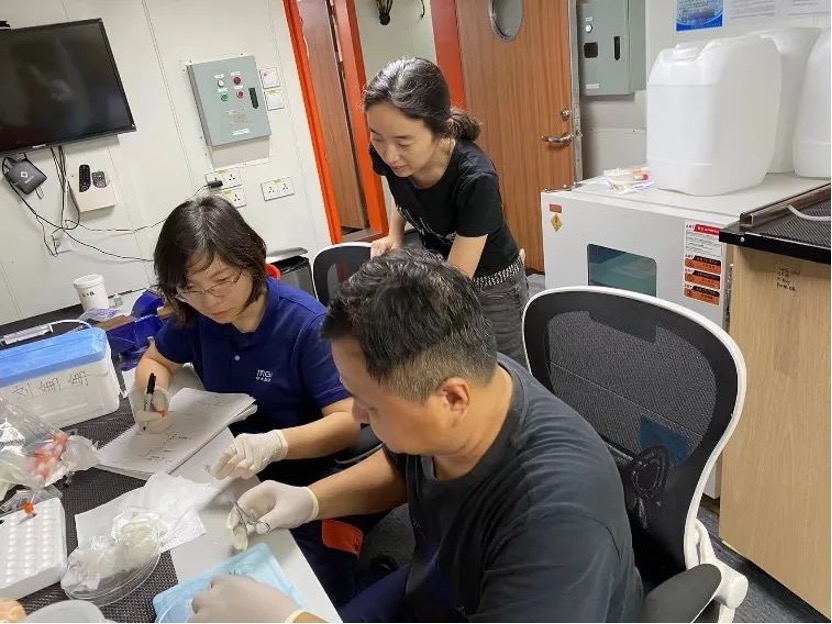The deep ocean is often believed to be devoid of light and nutrients; a barren ecological environment. However, the reality is very different. The depths of our oceans are teeming with a dazzling array of biological communities and abundant vitality.
In October 2021, a group of scientists, including Wang Jian, Chairman, and Co-founder of BGI Group, Xu Xun, Director of BGI-Research, and Liu Shanshan, Executive Dean of BGI-Research Qingdao, embarked on an ambitious expedition to explore one of the deepest parts of the ocean.
 Wang Jian (right), Liu Shanshan (middle), and Xu Xun on the exploration.
Wang Jian (right), Liu Shanshan (middle), and Xu Xun on the exploration.
Their destination was the "Challenger Deep" of the Mariana Trench in the western Pacific Ocean, the deepest known point underwater and often referred to as the "Fourth Pole" of the Earth (the other three being the North Pole, South Pole, and Mount Everest). It reaches a maximum depth of approximately 11,000 meters below sea level, surpassing the equivalent height of Mount Everest by over 2,000 meters.
The seabed represents a completely new and awe-inspiring ecosystem. The marine communities found there are not only abundant but also surpass what people typically encounter on land in both quantity and scale. Various marine organisms coexist harmoniously, creating a bewildering and captivating sight.
With each descent to a new depth, an entirely novel ecosystem emerges, showcasing different life forms and unveiling stunning new landscapes until reaching the seabed itself. The sheer awe inspired by this experience is indescribable, leaving one humbled by the magnificence of nature's hidden treasures.
The deep sea harbors a multitude of unique organisms with specialized adaptations. Some can withstand high pressures, others can thrive in oxygen-depleted environments, and some possess astonishing longevity. The genes responsible for these special adaptations are outstanding and priceless treasures.
 Liu Shanshan (left) and other scientists works on a research vassal.
Liu Shanshan (left) and other scientists works on a research vassal.
Exploring the depths of the ocean is undoubtedly a significant milestone in mankind's quest to comprehend life and its origins. During their expedition to the seabed, the team collected various marine life specimens, along with sediment and water samples, for species identification and biodiversity analysis. The knowledge gained from these invaluable specimens took them on a journey back to the origins and evolution of life, enabling a deeper understanding of how life originated and continues to evolve.
Xu Xun explained, “Through these explorations, we can further digitize the biodiversity resources of the global deep sea, gaining deeper insights into scientific questions about life's origin and extreme environmental adaptation. Additionally, these genetic resources will also contribute to our industrial applications.”
BGI's quest to understand the ocean is not a solitary one. In order to comprehend the full marvels of the ocean, BGI has launched or participated in a series of international research programs. Leveraging advanced genomics technology, these initiatives are aimed at contributing to global marine biodiversity genomics research.
Fish-T1K
In November 2013, BGI and the China National GeneBank (CNGB) jointly launched Fish-T1K, an international, collaborative, and non-profit initiative. Its aim was to generate RNA-seq transcriptome sequences for 1,000 diverse fish species, helping scientists unravel the mysteries of fish evolution and explore innovative approaches for addressing challenges in fish breeding, disease control and prevention, seafood safety, and biodiversity conservation.
The global collaboration also formed the Fish-T1K consortium, involving over 40 scientists from 25 institutions across seven countries. The Steering Committee, who provided valuable guidance and leadership, consisted of six core consortium members who were acknowledged experts in ichthyology, taxonomy, bioinformatics, phylogenetics, and evolution.
By May 2016, the project's first phase had successfully produced transcriptomes from over 180 ray-finned fishes, representing 142 species, spanning 51 orders, and comprising 109 families. These significant findings were published in GigaScience.
In May 2018, the Fish-T1K project achieved another accomplishment by officially announcing the construction of the most reliable fish phylogenetic tree to date. The "Tree of Life" for fish resolved long-standing debates and challenges related to fish origins and evolution, marking a historic milestone in fish evolution research. This groundbreaking finding was published in the Proceedings of the National Academy of Sciences (PNAS).
Subsequently, in May 2019, the Fish-T1K Special Issue was published in Volume 111, Issue 3 of the journal Genomics, signifying yet another significant milestone for the project. This publication underscored the tremendous potential of harnessing large-scale genomics data to accelerate progress in fundamental fisheries research.
Fish10K
As technology advanced, DNA sequencing became more affordable and accessible, opening up new opportunities for extensive research on oceans.
In September 2019, BGI and other institutes announced the launch of the Ten Thousand Fish Genome Project (Fish10K) during the International Conference on Genomics-Ocean (ICG-Ocean 2019). The project's objective is to sample, sequence, assemble, and analyze 10,000 representative fish genomes systematically over the course of ten years. It aims to create high-quality reference genomes for representative species in all orders (Phase I) and families (Phase II), while also generating draft genome sequences for additional related species (Phase III).
This ambitious plan is expected to provide a molecular foundation for conserving fish biodiversity and selectively breeding economically important fish species. Moreover, the initiative will establish critical groundwork for aquaculture, marine ecological conservation, and evolutionary research.
As of April 2023, Fish10K Phase I had collected a comprehensive genome dataset from 533 species, representing 86.59% of fish orders (71 out of 82). This dataset includes 115 newly sequenced species, specifically aimed at filling genome gaps for seven orders.
Mariana Trench Environment and Ecology Research Project
To uncover the true nature of the ocean, scientists decided to delve to its deepest depths.
In October 2021, a collaborative effort between Scientists from BGI Group, Shanghai Jiao Tong University, Institute of Deep-sea Science and Engineering at the Chinese Academy of Sciences, Zhejiang University, and Hainan Tropical Ocean University led to the launch of the Mariana Trench Environment and Ecology Research Project (MEER).
The project aims to create a standardized platform for sampling, processing, and analysis, while also establishing a long-term preservation and sharing system for samples and data during the investigation of hadal trenches. It focuses on addressing fundamental scientific questions related to hadal trenches, such as the formation and evolution of these deep trench systems on Earth, the origin and adaptation of life in these extreme environments, and the study and protection of biodiversity and natural habitats within them.
As part of the initial phase of the project, researchers have already completed the analysis of an impressive 92 terabytes of genetic data from deep-sea creatures. This substantial progress marks a significant step forward in advancing our understanding of the unique ecosystems and life forms that exist in the depths of the Mariana Trench and other hadal trenches.
The oceans serve as the cradle of life. As we move forward with projects like Fish10K, led by BGI, and other similar initiatives, we can anticipate a deeper understanding of ocean ecosystems. This progress will pave the way for more effective conservation strategies, sustainable aquaculture practices, and advancements in marine science. The continued collaboration and exploration of genomics data by BGI and other research institutions hold the potential to shape the future of marine research and foster responsible stewardship of our oceans for generations to come.
Source:
GigaScience: Fish-T1K (Transcriptomes of 1,000 Fishes) Project: large-scale transcriptome data for fish evolution studies
https://www.ncbi.nlm.nih.gov/pmc/articles/PMC4853854/
PNAS: Comprehensive phylogeny of ray-finned fishes (Actinopterygii) based on transcriptomic and genomic data
https://www.pnas.org/doi/10.1073/pnas.1719358115
Genomics: Special issue on fish transcriptomics
https://www.sciencedirect.com/science/article/pii/S0888754319302964
GigaScience: Initial data release and announcement of the 10,000 Fish Genomes Project (Fish10K)
https://academic.oup.com/gigascience/article/9/8/giaa080/5893976
CNGB: 10,000 Fish Genomes Project (Fish10K)
https://db.cngb.org/datamart/animal/DATAani16/



